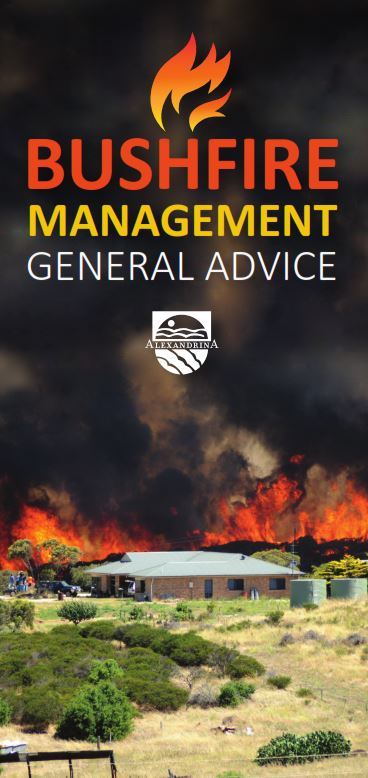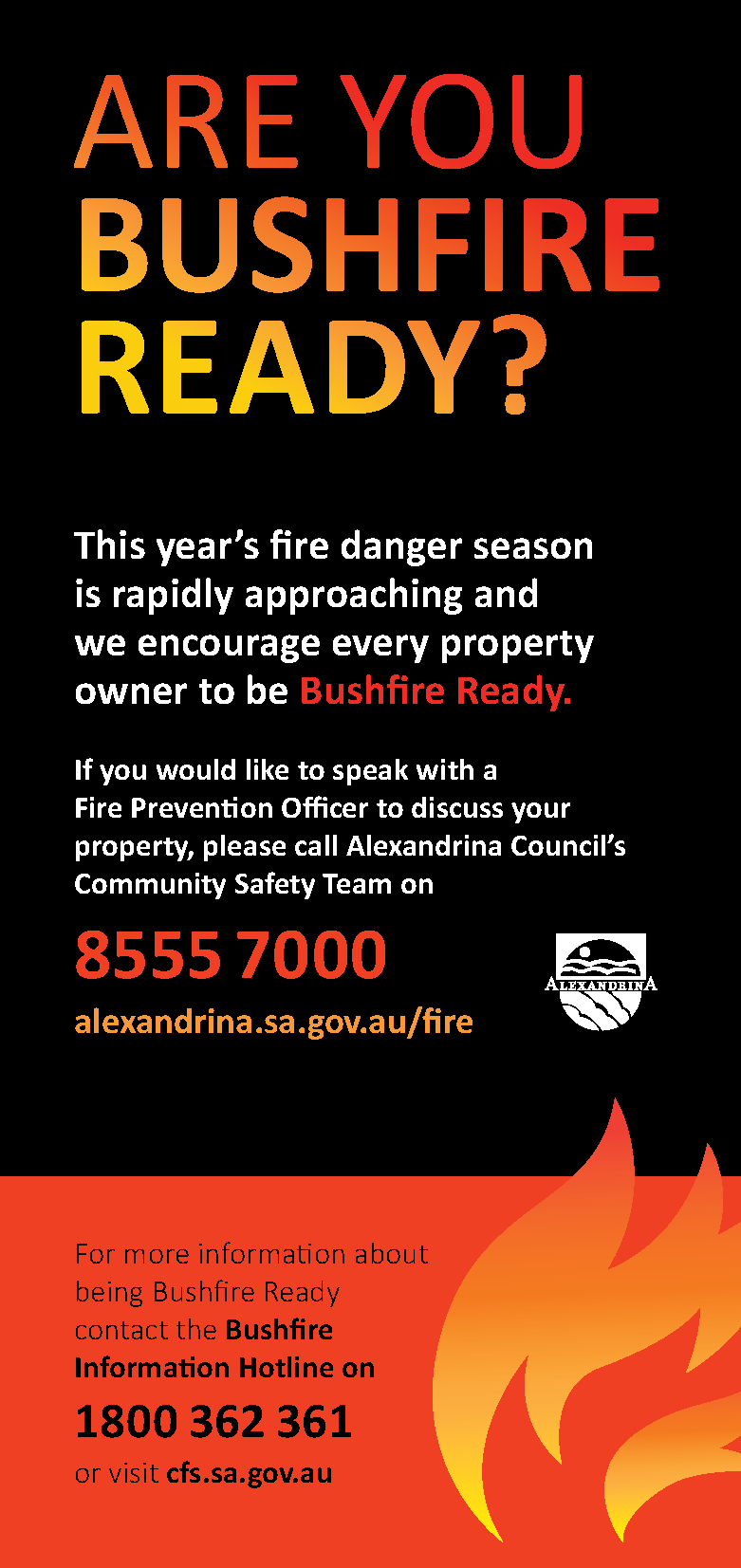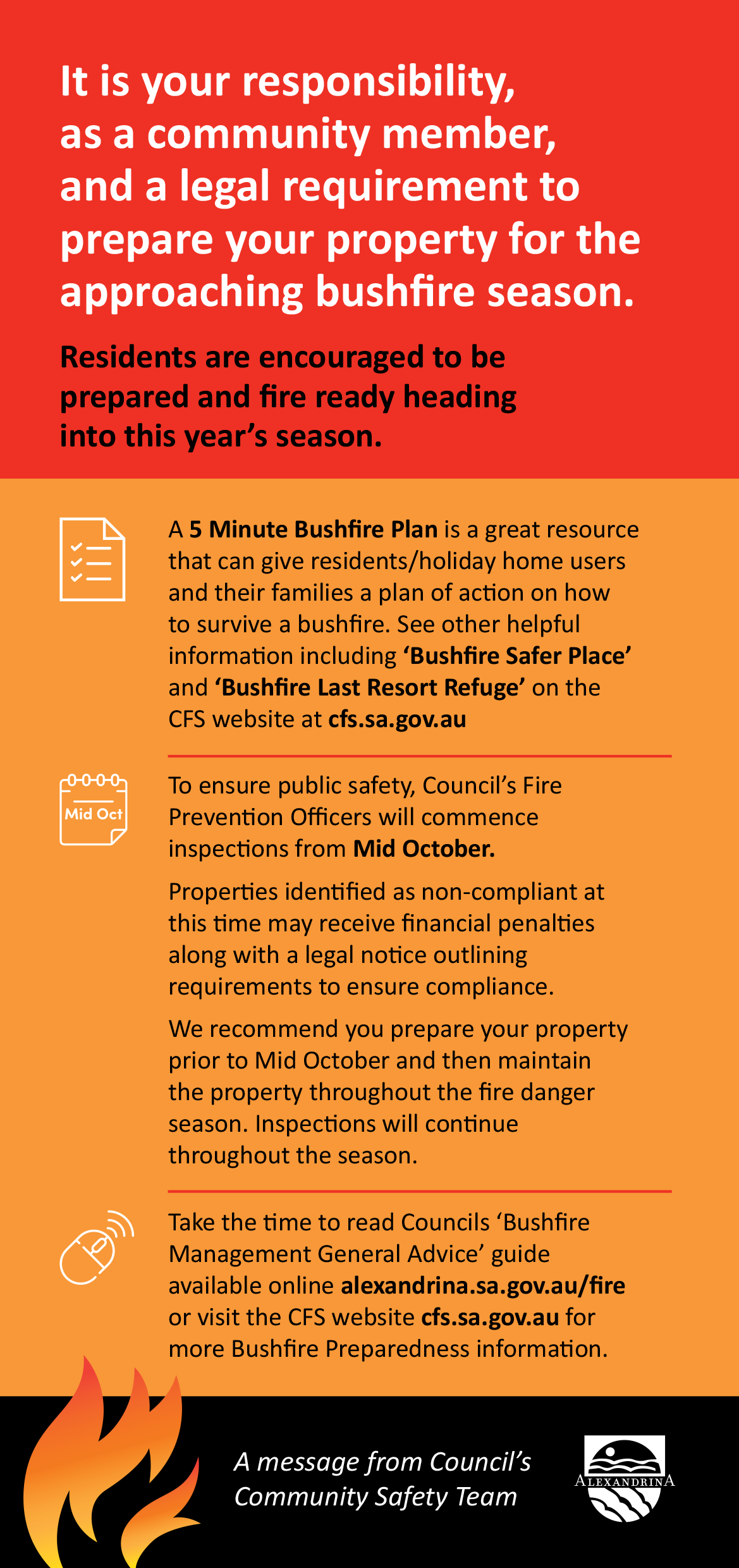Extreme Weather/ Bushfire and Emergencies, information below includes:
Fire Danger Ratings
Are you bushfire ready? General Advice brochure
Bushfire Preparedness and Native Vegetation
Personal Emergency Preparedness, Make a Plan
Bushfires and other Emergencies - Extreme weather events
List of Bushfire Safe locations - in the Alexandrina region
Adverse Event Plan – Drought Resilience
Burning Off/ Burning Controls - do's and don't
Alternative to burning rubbish
Other resources - Fire Prevention, Relevant Legislation, Agency/ Useful Contacts
2023/2024
Fire Danger Season Dates
Mount Lofty - 15 Nov 2023 - 30 Apr 2024
Murraylands - 1 Nov 2023 - 15 Apr 2024
Fire Danger Ratings have changed
You can read the CFS fact sheet - Australian Fire Danger Rating System
Bushfire Management General Advice
Alexandrina Council is committed to supporting residents to be bushfire ready.
As the property owner, you are responsible for ensuring the preparation of your property for the fire danger season. This includes installing and maintaining fire breaks and reducing fuel loads on your property.
Properties must be prepared prior to the Fire Danger Season and maintained to a standard throughout the Fire Danger Season.
Please refer to the Bushfire Management General Advice (above) and the Bushfire Ready (below) information brochures
Bushfire Preparedness and Native Vegetation
The management of fuel loads, including the selective management of native vegetation, is one of many steps landowners can take to prepare their properties for the bushfire season.
Removing grassy and woody weeds may be the most suitable method to reduce the fuel load on your property while retaining the environmental values associated with the native vegetation.
With the exception of some large trees within the 1956 floodplain area of the River Murray, you can now modify or removal all vegetation including native vegetation, within 20 metres of a prescribed building (e.g. a house or school) and within 5 metres of a prescribed structure (e.g. garden or pool shed) on your property, without approval from the Country Fire Service (CFS) or the Native Vegetation Council.
Authority to approve native vegetation clearance sits with the CFS. The CFS has a guide that provides a step-by-step process to follow when seeking to reduce, modify or remove native vegetation for bushfire safety.
For more information, please contact the Country Fire Service (CFS) for advice or visit the CFS website (www.cfs.sa.gov.au)
Personal Emergency Preparedness - Make a Plan
Emergencies may not be something we think about every day but they can happen. Knowing what to do and being ready is your best protection. With a simple plan, be prepared and cope better if an emergency occurs.
The Australian Red Cross has developed the Emergency REDiPlan to assist people to plan for any emergency:
Red Cross RediPlan
Red Cross RediPlan - Easy English
A range of other REDiPlan resources are also available. See the Australian Red Cross website to download booklets, plans, children’s activity books and more in various formats.
Bushfires and other Emergencies
Please find following the CFS List of Bushfire Safer Places in the Alexandrina Council area.
In South Australia we have become all too familiar with the devastating loss that takes place when natural disasters occur. Climate change will continue to increase the frequency and severity of extreme weather events, leading to even greater impacts on the South Australian people and government. Bushfires, floods, heatwaves, intense storms and biosecurity incidents have a significant impact on individuals, families and communities, and consequences for our people, economy, environment, and infrastructure.
All sectors of the community have a collective responsibility when it comes to emergency management. The State Emergency Management Plan outlines the roles and responsibilities of all those who play a part in emergency management – from state and local government agencies, to communities and individuals.
South Australia's emergency management arrangements are guided by the key principles of emergency management: prevention, which seeks to eliminate or reduce risk; preparedness, which puts people, plans, training and equipment in place to cope should an emergency take place; response, which involves activating the plans in place; and recovery, which involves community restoration after an emergency occurs.
The State Government's Emergencies website will provide vital information to assist you to:
- Improve your understanding of emergencies
- Identify who to contact for emergency assistance
- Understand the support that council and state government can provide before, during and after an emergency.
We strongly encourage you to become familiar with the contents on this website and make the appropriate arrangements to preserve and save the lives of you and your family, as well as to protect the environment, property and infrastructure where possible.
South Australia's Emergency Management Zones
Our state is divided into eleven Emergency Management Zones and each zone has developed its own Zone Emergency Management Plan. This system ensures that you have access to information on risks associated with natural disasters and other hazards specific to your relevant zone and provides you with information about minimising the impact to you and your family.
The Adelaide Hills, Fleurieu and Kangaroo Island Zone Emergency Management Plan is available on the South Australian State Emergency Service (SES) website.
Adverse Event Plan – Drought Resilience
Alexandrina Council acknowledges support from the Federal Governments Drought Communities Program to progress Councils Adverse Event Plan – Drought Resilience. As well as economic stimulus, the Drought Communities Program seeks to build resilient communities that can plan for and manage adverse events. The Adverse Event Plan has been prepared by Alexandrina Council to meet the requirements of the program and specifically to improve Council preparedness for drought.
The Adverse Event Plan purpose is to:
- Demonstrate the systems, capacity and resilience of Council and it’s communities for managing adverse events
- Provide ongoing value to those communities in relation to prevention, preparedness, response and recovery to adverse events
- Nominate critical projects, gaps and future opportunities that can improve the resilience of communities to adverse events
- Assist in identifying and mitigating strategic and operational risks to Council from adverse events.
The Adverse Events Plan provides a framework-based assessment which draws on relevant context and direction for managing adverse events and reflects key considerations in the areas of:
- Communication and coordination
- Natural resource management
- Economic diversification and community resilience.
The framework approach is set within the statutory considerations provided by local government strategic, risk and emergency management planning. It does not seek to duplicate these established frameworks. Rather the Adverse Events Plan seeks to inform established frameworks by identifying gaps and opportunities to build resilient communities.
Burning Controls
Current burning controls exist to reduce the danger of fire and to minimise the nuisance, which can be caused to other residents by smoke. Residents are encouraged to advise their neighbours whenever possible, before lighting a fire.
There are a number of conditions that must be adhered to for all types of burning:
- burning is not permitted in any street, road or laneway
- burning timber with any chemical preservatives (e.g. permapine, creosote) and burning any prohibited substances is also illegal
- the space immediately around and above the fire must be cleared of all flammable material to a distance of at least 4 metres
- a supply of water adequate to extinguish the fire is on hand at all times
- a person (over the age of 16 years) who is able to control the fire is present at the site of the fire from the time it is lit to the time it is completely extinguished.
All fires, including those in an incinerator are prohibited on a Total Fire Ban Day ($10,000 penalty applies).
A: There are different rules for burning depending on whether or not it is within the fire danger season. The dates for the fire danger season are:
- MOUNT LOFTY RANGES 15 November - 30 April
- MURRAYLANDS 1 November - 15 April
(Note: Subject to change, dates may change annually depending on seasonal conditions)
Burning can take place outside of the Fire Danger Season for the Mount Lofty Ranges Fire District and Murraylands unless otherwise stated.
A: For burning information during the Fire Danger Season please see the following link for updated and current information
A: In a built-up area, charcoal is the only material allowed to be burnt. This can be done in a fire no bigger than 1 square metre. When burning, it is illegal to cause a smoke nuisance to neighbours and other persons in the local area. Outside of built-up areas the burning of agricultural, forestry waste or broad-acre burning may be considered as long as the relevant burning code of practice is adhered to. Codes of practice can be found at the following link
A: For the purpose of this Burning Control Fact Sheet: If you live in an area that Council provides a green waste collection service, Council would determine you are located ‘In a Built-up area.’ If you live in an area that Council does not provide a green waste collection service, Council would determine you are living ‘Outside of a Built-up area.’
A: Any smoke generated from a fire (in the open) or combustion heater that affects a neighbour or is likely to affect a neighbour may attract fines of $500 or significant maximum penalties. This applies to all burning, throughout the entire year.
A: Yes, Council recommends only the use of charcoal. Dry wood and dry plant material may be used but the person lighting the fire should consider and avoid causing a potential smoke nuisance. But use of these items is not permitted during fire danger season without a permit. Permit will only be considered on total fire ban days for emergency uses.
A: In areas that have an allocated green waste collection it is prohibited to burn any green plant material. Outside built-up areas this practice is accepted as long as the relevant burning code of practice is adhered to. During the fire danger season a schedule 9 permit is required and during a total fire ban any fire is prohibited.
A: Yes, as long as the size of the fire is restricted to a size adequate for the purposes of cooking. Council recommends only the use of charcoal to minimise the potential for smoke nuisance. Dry wood and dry plant material may be used but the person lighting the fire should consider potential smoke nuisance.
During fire danger season a fire is allowed provided the following criteria is met:
- A 30cm deep trench and no more than 1Sqm in area
- A 4 metre cleared space of flammable vegetation is cleared around and above the fire
- A responsible person is in attendance at all times with water and or extinguisher
The use of fires for cooking or personal comfort are not permitted on total fire ban days without a permit.
A: Yes, the fire must be contained within a properly constructed incinerator of masonry construction. It must be able to contain fire/sparks on all sides and having a capacity of less than 0.25 cubic metres. Within in an incinerator you may only burn charcoal, dry wood or other dry plant materials. This applies year-round, but is not permitted during fire danger season or on total fire ban days without a permit.
A: Yes, Council recommends only the use of charcoal. Dry wood and dry plant material may be used but the person lighting the fire should consider and avoid causing a potential smoke nuisance. During fire danger season these can be used provided:
- The BBQ is clear of all flammable vegetation to a distance of up to 4 metres
- A person who is able to control the fire is present at the site of the fire until it is extinguised
- An appropriate extinguisher is at hand
There is NO BURNING OR USE OF SOLID FUEL COOKERS ON TOTAL FIRE BAN DAYS.
A: No burning or use of incinerators or solid fuel cookers are allowed on total fire ban days.
Please see the following CFS website to find out "What_can_I do?_What_can't_I_do" for further details.
Alternatives to burning rubbish
Waste materials can be disposed of through the kerbside general waste or kerbside green organics collection service operated by FRWA for those households where collections occur. Refer to the FRWA website for further information. Outside of collection areas, general household refuse including gardening refuse can be deposited, for a fee, at Goolwa Waste and Recycling Depot (8555 7405) on the Goolwa to Victor Harbor Road.
This facility is open Monday to Friday 7.30am to 4.00pm. Saturday 9am to 3:30pm.
Relevant Legislation
Burning controls are stipulated in the Fire and Emergency Services Act 2005, Environmental Protection Air Quality Policy 2016 and Local Nuisance and Litter Control Act 2016. Breaches of these Policies and Acts may result in fines.
Further reading:
Better air quality for all of us, know South Australia’s Laws for Burning in the Open.Tips on how to Burn Better for Good from the EPA (Environment Protection Agency).
Agencies - Useful contacts
Environmental Protection Authority – 8204 2004
Country Fire Service Hotline – 1800 362 361
Alexandrina Council - 8555 7000
For further information about burning controls that apply within Alexandrina Council please contact
Council’s Fire Prevention Officer on 8555 7000 or send an email to alex@alexandrina.sa.gov.au
This information should be used as a general guide only.
Helpful Resources
Our country and region can be prone to extreme weather conditions, which include: bushfires, extreme heat, and storm occurrences.
Here are some useful resources to help you prepare for and respond to extreme weather events:
Fire Prevention - What you need to Know
Fleurieu Bushfire Management Area Plan - Dec 2017, the Plan may also be read in conjunction with the interactive map here.
CFS - What I can do/What I can't do
Fact Sheet Campfires and BBQs
Community Fire Safe Brochure
Nine and Tenth Schedule Permit Information
Reducing Fire Risk in Gardens
Bushfire Safety
Guide to Bushfire Safety - Also available as a hard copy at Goolwa and Strathalbyn Council offices.
Bushfire Safer Places
Bushfire Traveller Safety
Bushfire Safety and Survival for Businesses and Organisations
Involving your kids in Bushfire Planning
Country Fire Service
For any information either call the CFS Bushfire Hotline 1800 362 361, or go to the CFS website (cfs.sa.gov.au)
Before a fire -
Make a Bushfire Plan
During a fire - What to do
Business and Farms Fire Safety
- State Emergency Service
- Bureau of Meteorology (BoM)
- SA Government
- Primary Industries and Regions (PIRSA)
- RSPCA
- Red Cross
For further information, please contact Alexandrina Council on 8555 7000 or via email to alex@alexandrina.sa.gov.au



